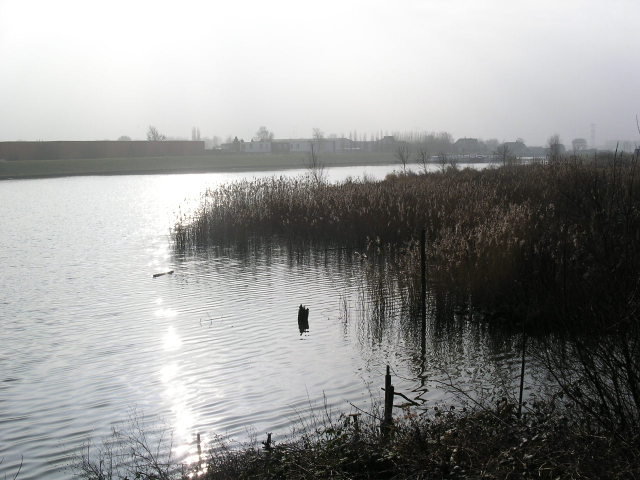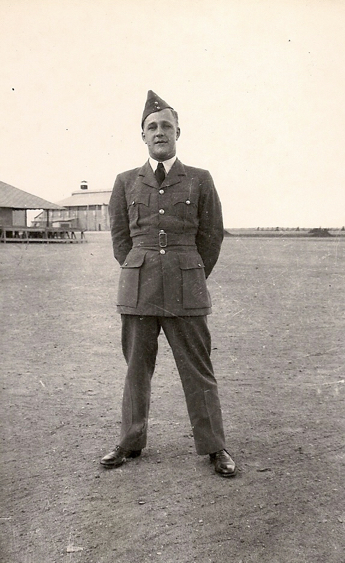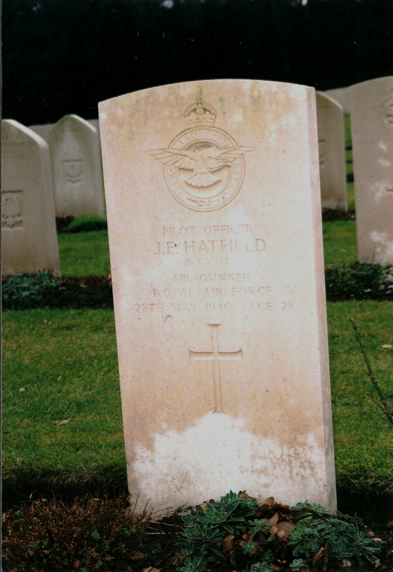Date: 13th May 1940 (Monday)
Unit: No. 264 Squadron
Type: Defiant I
Serial: L6969
Base: Duxford (via Martlesham)
Location: Donge river, Geertruidenberg, The Netherlands.
Pilot: F/Lt. George Skelton. Injured - P.O.W.
Air/Gnr: P/O. Jack Elmer Hatfield. 40474 R.A.F. Aged 28 – Evaded.
 cc
cc
Above left: F/Lt. George Skelton. Right: P/O. Jack Elmer Hatfield (Source: The Hatfield family via Jan Jolie)
REASON FOR LOSS:
Took off at 04.15 hrs from Martlesham along with 5 other Boulton Paul Defiant's and 6 Spitfires from 66 Squadron. The object being to patrol the Dutch coast between Ijmuiden and the Hague to attack German troop transport.They flew across the North Sea, making landfall about ten miles north of The Hague at 0515, after which all aircraft turned north.
Over IJmuiden they were fired on by Dutch anti-aircraft guns located on the south side of the harbour. The guns were firing accurately but they ceased fire immediately the British signalled the Dutch letter of the day. All aircraft turned about and flew south along the coast. More fire, this time German, was met over Maassluis which caused sections to take evasive action.
Shortly after, the No. 66 Squadron Spitfires turned east towards Rotterdam where there were fires raging in various places while the Defiant's followed a more southerly route. Approaching Rotterdam, the crews of both flights saw about seven German Ju 87 Stukas (belonging to 12. Staffel of Lehrgeschwader 1) dive-bombing a target to the south-east.
The Defiant's went in to the attack and a ferocious air battle developed. Shortly after, Bf 109's from 5. Staffel of Jagdgeschwader 26 joined the battle, which then developed into a series of individual dogfights.

Defiant I L6969 taken shortly after the crash (Source Jan Jolie)
Hit by German fighters, the pilot of Blue 1, Flight Lieutenant George Skelton, lost consciousness and the aircraft went into a spiral dive. His gunner, Pilot Officer Jack Hatfield, tried in vain to contact his pilot and finally abandoned the plane. He later filed the following report:
‘I was air gunner to Flight Lieutenant Skelton who was leading the formation of Defiant’s during the operations May 13, 1940. Skelton was leading 'B' Flight of No. 264 Squadron. We encountered near Rotterdam, at about 0545 hours, seven Ju 87s and about 25 Me 109s. About two miles from Rotterdam the Defiant's had to break formation as a dogfight had developed.
When we were attacked by one Ju 87 who was on our tail about 50 yards away, I told Flight Lieutenant Skelton to bank away but received no reply. At the same time another Ju 87 came up on our tail accompanied by an Me 109 on the left. I shot down the first Ju 87. By this time our own aircraft was in a steep spiral turn and the second Ju 87 continued to follow us.
‘I could not get in touch with Skelton so I think he was probably killed in the first encounter. Our aircraft started to spin and I managed to escape from the top of the turret with only one door open. I must have pulled my parachute automatically because I was not conscious until I landed in some water. I remember that the Ju 87 was firing incendiary bullets and my elbow was injured.
‘I swam ashore and stayed in the reeds for about two hours and then swam to another island. While in the water I saw a boy and a girl in a boat [Piet and Iet Saarloos] who took me to their house. I questioned the man of the house and by sign language was told that three English and one German parachute had come down. Apparently our aircraft had spun in about one mile from this house and had blown up. The name of this place was Biesbosch. I tried to bribe the man to take me to the crash to see if my pilot was dead or wounded, but I was assured that the aircraft had exploded and the people would not take me across the river.
‘At about 1200 hours I was rowed across the river by one of the neighbours and was met by two boys on bicycles [Martien van Lent and Piet Saarloos] who took me on the back of one to the place where I met Pilot Officer Thomas of Blue 2. I noticed that most German aircraft were flying at about 1,500 feet. There was no opposition and very little anti-aircraft fire. All the Dutch military that we encountered appeared to be very angry that the English had not given them more air assistance.’

(Source Jan Jolie)
Recent research has revealed what really happened when L6969 crashed. A misleading story of one eyewitness had suggested that the aircraft which crashed and exploded near a small hut on Buisjes island in the Biesbosch wetlands could have been Skelton and Hatfield's, but this was not so. (This aircraft was in fact one of the four Stuka's shot down during the dogfight.)
After Hatfield had left the aircraft by parachute, Skelton regained consciousness and, being wounded and possibly to low to bail out, tried to save himself by gliding down to a strip of reeds to break his impact. He made a perfect emergency landing at the edge of the Donge River south of the town of Geertruidenberg where the wrecked aircraft would remain for a considerable time.
During high tide only the tail was visible above the water and once, at low tide, a Dutchman even climbed into the cockpit. Apparently the Germans or the Dutch later removed the wreckage, although it is possible that parts of the aircraft still remain under water. No one ever understood how Skelton, badly wounded in the arms and legs, could have made such a good landing but the facts can now be confirmed after many years thanks to a photograph of the Defiant that came to light during the research for this story. Skelton was found in the water by a Dutch skipper, Chiel Olme, who took him ashore in a rowing boat.
The seriously injured pilot was brought to the St Theresia Hospital at Raamsdonksveer, where Dr. Charles Lips treated him. Initially the hospital staff hid Skelton but eventually the Germans found him and he was transferred to Germany where he remained in various camp hospitals until, due to his injuries, he was eventually repatriated to Britain via Sweden in 1943.

The crash site today (Source Jan Jolie)
Post script:
Fl/Lt. George Skelton:
Thanks to the treatment he received from German doctors, Skelton was later able to fly again. In late 1944, after France had been liberated, he spent some time in Cannes with his wife and family to speed up his recovery. He later carried out administrative and technical duties in the RAF and in 1945 he was promoted to Squadron Leader. Two years later he was further promoted to Wing Commander and, from December 1948 to December 1950, served as Air Attaché in Prague. In 1952, now a Group Captain, he took a course at No. 101 Flying Training School to maintain his flying skills and later took a further course at No. 215 Advanced Flying Training School at Finningly. In 1954 he was posted to 2nd Tactical Air Force in Germany and in April 1956 promoted to Air Commodore. In 1959 he was appointed Chief of Air Staff but he left the service on his retirement later that year and returned to the south of France with his wife. His health deteriorated in 1979 and he returned to England for treatment. He died in King Edward Hospital in London on October 18, 1985, aged 76.
P/O. Jack Hatfield:
Pilot Officer Hatfield returned to England the day after he was shot down. Together with Pilot Officer Samuel Thomas of Blue 2, he was able to secure a place aboard a British warship that left Hook of Holland late on the 13th and arrived at Dover the following evening. Both men rejoined No. 264 Squadron. On the afternoon of May 23, the squadron took off from Manston to cover the French coast over Dunkirk, Calais, and Boulogne. Hatfield flew with pilot Sergeant John Lander. Seven Bf 110s were sighted, one of them diving to break up the British formation. The other six followed, but seeing that the Defiant's maintained good formation they climbed back into clouds. That evening the squadron flew a similar patrol together with two Hurricane squadrons but no enemy aircraft were sighted.
From May 26 to June 3 there were almost constant air battles over Dunkirk, as part of the aerial cover for Operation ‘Dynamo’, the evacuation of the British Expeditionary Force from France. The Defiant's of No. 264 Squadron were heavily involved, with May 29 proving a big day when they claimed eight Bf 109s, nine Bf 110s and a Ju 87. However, Jack Hatfield did not live to see that day. The day before, May 28, he had taken off from Manston with Pilot Officer Alexander McLeod to patrol Dunkirk. They failed to return from a combat with Bf 109s having been shot down in the sea. Hatfield's body was later washed ashore and he was buried in Germany, his remains being re-interred after the war in Becklingen War Cemetery at Soltau, McLeod's body was never found and his name appears on Panel 9 of the Runnymede Memorial.

P/O. Hatfield (Source Jan Jolie)
Burial Details:

P/O. Jack Elmer Hatfield. Becklington War Cemetery 26.D.4.
Son of Elmer Calvin Hatfield and Enola Vaughan Hatfield, of Tusket, Yarmouth Co., Nova Scotia, Canada. A.C.B.A.
Researched by Jan Jolie (Dutch researcher) for the Aircrew Remembrance Society, December 2013


The British Library is preserving this site for the future in the UK Web Archive at www.webarchive.org.uk All Aircrew Remembered on our Remembrance pages, are therefor not just remembered here, but also subsequently remembered and recorded as part of our nation’s history
and heritage at The British Library.
Aircrew Remembrance Society 2013 © David King, Melvin Brownless & Alexander King.

